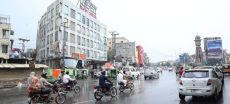Imagine this: you’re all set to make your morning tea, turn on the tap… and nothing! Not even a drop. For millions of Pakistanis, this isn’t a funny scene; it’s real life. The water crisis in Pakistan is growing, knocking on doors from Karachi to Quetta. But the good news? There’s a lot we can do to help.
Causes of Water Scarcity in Pakistan
Pakistan’s water problem didn’t appear overnight. It’s a mix of human activity, climate change, and outdated systems creating stress on our precious resources. Cities are growing fast, farms are thirsty, and Mother Nature isn’t always predictable.
The main culprits include population growth, overuse of groundwater, poor infrastructure, and pollution. For example, Lahore is facing a serious water contamination crisis affecting millions.
Before we dive into the main culprits, here’s a quick snapshot of the biggest reasons Pakistan’s water is running low:
- Groundwater Overuse: Wells dry faster than they can refill.
- Old Infrastructure: Leaky pipes waste huge amounts of water.
Beyond that, inefficient farming practices and erratic rainfall patterns are accelerating the problem. Together, these factors have put Pakistan on the global water stress map.
Consequences of The Water Crisis in Pakistan
The shortage isn’t just about inconvenience; it affects health, the economy, and society. Contaminated water spreads diseases, water scarcity impacts farmers’ livelihoods, and cities struggle to meet demand. It’s a chain reaction that touches every part of daily life.
Communities face unequal access: the poor suffer the most, while urban centers battle patchy supply. Health issues like diarrhea, hepatitis, and other waterborne diseases are becoming more common.
To understand the full impact, take a look at how water scarcity is affecting the environment:
- Environmental Effects: Shrinking rivers and wetlands threaten wildlife.
- Economic Effects: Crop failures lead to rising food prices and financial strain.
So, the water crisis is not just a tap problem; it’s a real-life challenge affecting millions of Pakistanis every day.
Urban Water Crisis in Major Cities
Some cities feel the water crunch more than others, depending on geography, population, and infrastructure. Karachi, Lahore, Islamabad, Peshawar, and Quetta face unique challenges that make their water situation urgent.
In Karachi, rapid urban growth and groundwater overuse create huge pressure. Lahore struggles with pollution and ageing pipes, while Islamabad relies heavily on seasonal rivers and rainfall.
Let’s break it down city by city so you can see which areas are most at risk and why:
- Karachi: Coastal aquifers are salty; water cutoffs are frequent.
- Lahore: Industrial waste and sewage pollute drinking water.
- Quetta: Extremely arid climate and limited natural water sources.
Peshawar and Rawalpindi face growing urban demand and outdated systems, making daily water access inconsistent and unreliable. Each city’s problem is a little different, but the solution requires everyone’s effort.
How to Contribute to Solving the Water Crisis
Feeling like the water crisis is too big to tackle? Don’t worry! Even small changes at home or in your community can make a huge difference. Every drop we save counts, and habits like smart usage and awareness can inspire bigger action.
You can start with simple steps like fixing leaks, using efficient appliances, or harvesting rainwater. Reusing grey water for plants or toilets is another practical solution that reduces waste.
Here’s a handy list of actions you can take to save water and make a real difference in your home and community:
- Gardening Smart: Water early morning/evening; choose native or drought-resistant plants.
- Awareness & Action: Talk to friends, family, and neighbors about saving water.
Supporting clean water projects, reporting pollution, and practicing mindful water use ensure a positive ripple effect. Together, these small steps can help Pakistan turn the tide on its water crisis.
Way Forward
The water crisis in Pakistan isn’t far away; it’s affecting homes, schools, farms, and cities right now. But hope is not lost. Start small, act smart, and encourage your community to do the same. Every drop saved is a step closer to a sustainable future.
Take action today: fix leaks, reduce waste, reuse water, and share this blog to spread awareness. Let’s turn awareness into action, because every drop counts!











